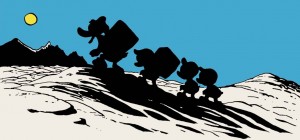
Sir Edmund Hillary, Mount Everest's iconic conqueror, once said "It is not the mountain we conquer, but ourselves." Increasingly though, since Hillary and Sherpa Tenzing Norgay first reached the summit in 1953, the world's tallest mountain has become ourselves.
A new scourge facing Mount Everest, according to Ang Tshering, the head of Nepal’s mountaineering association, is human waste. “Climbers usually dig holes in the snow for their toilet use and leave the human waste there,” the AP reported on Tuesday. If there is too much waste in a single hole, the material cannot decompose properly.
Tshering also noted that hundreds of foreign climbers visit the site each year and that there is no plumbing above base camp. In addition to making the mountain less pristine, officials say the dumping, if you will, also poses a health hazard.
The association has a detailed guide for the handling of human waste, dedicating as many lines of instruction to the endeavor as the disposal of garbage. Nepal requires climbers to bring down everything they take up or lose a $4,000 deposit, but there is no such penalty for improperly disposing of organic material. Wildlife can be drawn to the unfamiliar scent and vegetation can be disturbed, according to the association. The group is drawing attention to the hazard because the climbing season begins this week and as more adventurers chase the peak, camps are being spoiled with human waste.
Writing in The Atlantic, Kaid Benfield detailed an annual voyage by locals called the Eco Everest Expedition, which in 2011, sought to "bring down 8,800 pounds (4,000 kilograms) of garbage from the lower part of the mountain and another 2,200 pounds (1,000 kilograms) from near the 29,035-foot (8,850-meter) summit. As he writes, that detritus includes "empty oxygen bottles, ropes, tents, and other garbage."
Then, there are the human deaths on the mountain which, as Svati Kirsten Narula pointed out last year, total nearly 900 from 1950 until today. Some 16 climbers died in one deadly ice release last year, which some blamed on another man-made phenomenon: global warming.





































 Like any masterpiece, Carl Barks' 1949 comic book story "Lost in the Andes" means many things to many critics, each one finding something new with every reading.
Like any masterpiece, Carl Barks' 1949 comic book story "Lost in the Andes" means many things to many critics, each one finding something new with every reading. 














